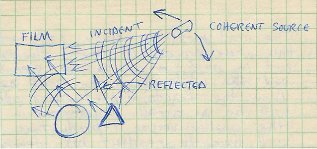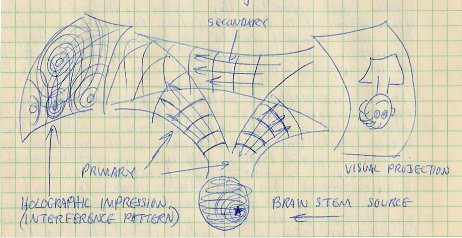Recent research into brain functions has failed to find any trace of specific locations for specific memories. It appears that memories are somehow stored throughout the whole of the cerebral cortex frontal area or at least throughout a sizeable portion of it. Thus damage to a part of the memory area does not necessarily result in a loss of memory. The brain also appears to have a very large memory capacity that in the case of the majority of people never gets completely filled up, although there may be some exceptions to this: for example, people who are said to be in their second childhood. The memory function and its retrieval system could be considered quite baffling especially when people try to build models of it using current computer and data processing philosophies.
This discussion departs from the conventional serial storage memory concept and borrows from the rapidly growing field of laser holography to present a model for memory processes. There are several points within the discussion where the reader is left to his own imagination and background to conceive of the particular mechanism that may be operating. The underlying purpose thus, is to present a framework on which to build a viable theory regarding the human memory.
In laser holography one of the techniques of recording graphic information is theoretically and to a limited degree almost practically, capable of storing an infinite or at least a very large number of different pictures, all within the same photographic emulsion. The diagram on page 29, top, depicts this technique.
Page 29

The coherent source illuminates a scene to be recorded. Part of the coherent light travels directly to the photographic emulsion and is called the incident or reference energy. Light reflected/refracted from the objects also impinges on the emulsion. The two forms of energy, incident and reflected, interfere with one another within the emulsion and create a hologram or an interference pattern. Other scenes may also be recorded on the same emulsion without degrading each other, by moving the coherent source to different locations.
After a sufficient number of interference patterns are registered on the emulsion it can be processed chemically to produce a "playback" device. By placing the developed emulsion back into its original holder, each scene previously recorded, can be re-created by illuminating the emulsion with a coherent source positioned at the same locations as were used in exposing the film. Some emulsions have recorded up to 100 scenes in this fashion and the limiting number is a matter of technological expertise and materials. The viewer of the reconstructed scene has to place himself at the proper location to view the series of pictures. [This last sentence is probably not true nor needed. 01 Mar 2006.]
Page 30
The next most, or equally, fascinating aspect of this whole process is that the emulsion can be cut in half or quarters or even smaller pieces and the whole scene can still be reconstructed from the fractional part being used. True, there will be an overall degradation in the quality of the smaller version reproductions and the viewer will have to restrict his viewing angle due to the smaller size of the film, but the entire scene, as visible from the particular viewing angle will be reproduced.
A means of providing rapid flashback can be had by programming the coherent light source to jump from position to position in sequence. Movies could even be made by a rapid fire recording technique where the light source would move in short increments and flashing at each stop.
Now comes the biological hologram. Let us hypothesize a coherent source of biological (electrical) impulses within the brain stem that could illuminate the bodily projection areas of the cerebral cortex and the frontal "memory" area. Lets discuss the visual portion of memory first, but keep in mind that the other sensory areas can be (and must be) included once the concept is clearly grasped.
Let the frontal cortex be a holographic medium for bio-electrical interference patterns. Suppose a visual pattern is registered in the occipital area (rear) of the brain. This will be represented by varying levels of electrical activity as a function of the light levels impinging on the retina.
Page 31
Now, somewhere down in the brain stem, let there be an irritated neuron that is firing a train of nerve impulses to its surrounding neighbors, which in turn fire off secondary impulses. After successive repetitions of this process by other neurons in the stem mass a repetitive wave front will be generated and will be propagated througout the entire cerebral cortex via nerve bundles that radiate away from the brain stem. (These radiating fibers could possibly be from the thalmus region or perhaps the reticular formation. At this writing I haven't dug into the matter deeply enough to get a good handle on it.)
These bio-electrical pulse trains that make up the repetitive wave fronts have a parallel to the coherent wave fronts or waves of the laser. When the wave fronts impinge on the visual projection area, secondary wave fronts will be generated that will travel to the frontal memory area via fiber bundles that traverse the brain fore and aft. The intensity of the secondary wave front from any portion of the visual projection area will be a function (function undefined) of the state of electrical activity at that point.
When the secondary wave front (which has the same frequency or repetition rate as the primary) reaches the frontal area, interference will occur between primary and secondary waves, and the overall interference pattern will recorded electrochemically in the frontal area. Again, the actual recording mechanism is not defined here but is left to the reader to define.
Once a given number of impulses are generated by the originating neuron in the brain stem, it will taper off (probably due to exhaustion) and one of its neighbors will go into spasm, and carry on the process -- but with the noticible and important difference that the waves are now originating from a new source location. This parallels moving the
Page 32
laser source as in laser holography, and allows subsequent impressions to be recorded in the same medium. Probably at birth, or somewhere back there, the process starts with a given neuron firing off and the subsequent locations of the wave front source being a logical function of the brain's construction, in that region. The active source neuron pattern might be a spiral chain or some such arrangement.

To recall any given memory, the control aspect of the brain would turn off (or reduce) activity from the "here and now" wave front source in the stem, and by some slight of hand arrange for the neuron in the stem that is associated with a given event [in the past] to start firing. The control would also have to inhibit or stop paying attention to the visual image coming from the retinas. As in laser holography the biological wave front, that is called up, will illuminate the frontal area and [the] visual projection area (or perhaps the personal area of the concious mind, which might be separate from that [which] is associated with [occipital] retinal images) and produce a "readout," [which is] visual in nature, based on the stored interference pattern in the frontal area. [The last half of this paragraph is probably in need of some serious revision.]
Page 33
The construction of the stem mechanism (or wherever the pulse generator function is) would be such that whenever a memory is being reviewed, the original series of neurons would fire off in the same sequence, thus permitting "running the record" until the proper scene is recreated. The "A HA!" function could be wired in to keep the playback gain low until the desired info is found.
A person's ability to recall a given event would be related to his control function regarding turning on the correct neuron, to evoke the desired memory. Malfunctions, or dead cells, (natural or otherwise) in the brainstem might make portions, or all, of certain memories unavailable for voluntary recalls. (Certain memories might appear "slippery.")
It seems that there must be a finite limit to the number of impressions that can be stored using this model, because there would be a finite number of "source" locations within the stem. If a person lives longer than his supply of new source locations, or centers for the bio-electrical wave fronts, his brain stem may in fact reset itself to "zero" and presto, the individual is in his second childhood. True, he could do some recording over the original memories, but his recording mechanism, at [current] age will probably not be as good as when new, so the individual would live a double life, his childhood memories being superimposed on his present world impressions. His behavior and responses would most likely be directed toward the stronger of the tug-of-war contestants for his attention.
This discussion does not make an attempt to define that aspect of us that seems to interpret, enjoy, or [to] act on the present and recalled impressions. Rather it addresses only the tools that are at its disposal.
Robert S. Fritzius, VQ1 NAS Agana, Guam
Read and understood by Lester B. Lekenby and Timothy B. Hogle, 17 March 1975.